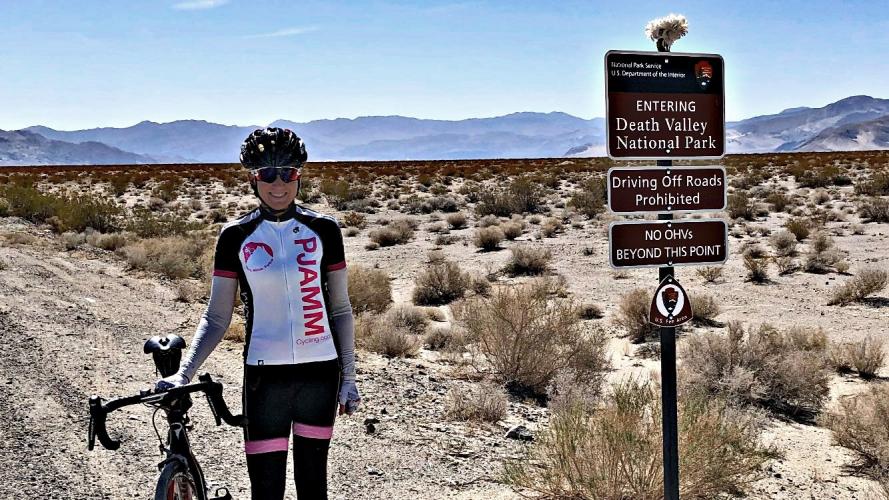![]()
Cycling Death Valley Road - a Top 100 US Bike Climb in a very hot venue.
Cycling Death Valley - PJAMM’s list of Top Death Valley bike climbs.
![]()
Ride 15 miles gaining 4,735’ at 5.4% average grade (5.8% climb only)
Death Valley Road is at the northern tip of Death Valley National Park and on some maps is referred to as "Big Pine Road" which passes through several points with distinctly Death Valley nomenclature (e.g. Crankshaft Junction and Last Chance Mountain) on its way to the start which begins at Scotty's Castle. This is the northernmost of the 10 Death Valley climbs on our index (Death Valley-Las Vegas Page) and while we have climbed Death Valley Road West during the Everest Challenge, we have yet to personally experience this climb.
![]()
STRAIGHT is a constant in Death Valley.
![]()
![]()
![]()
Stay away or ride early late May to October.
DEATH VALLEY WEATHER
![]()
Climb summary by PJAMM friend and contributor Dan Razum, Campbel, CA.
The Death Valley Road East climb starts in Eureka Valley at the northern edge of Death Valley National Park.
The road is dirt on the valley floor on the way to the climb from the east, but pavement starts at the beginning of the climb and is paved throughout.
![]()
Transition from dirt to pavement at the start of our climb.
There are 3 distinct sections of the climb, each separated by a short downhill portion. We start climbing out of
Eureka Valley along an alluvial fan[1] for the first 5 miles or so. The gradient hits double digits a few times in
this section, which, together with hot temperatures and lack of shade, can be a bit taxing. The scenery in this
section is pure Death Valley, scorched hills with some sagebrush and small plants and long straight stretches
of road. The straight road disappearing into the distance can distort perspective, so it often seems like you're
not moving at all, but keep pedaling and you'll get there eventually!
![]()
View of alluvial fan to the left.
![]()
Looking back at the barren desert as we climb out of the valley.
The alluvial fan gently merges with the mountains and we come to a short intermediate descent. We then continue
to climb for another couple of miles and we come upon a second intermediate descent, which takes us into a small
valley. The hard part is now behind us and the gradient is less steep here. There are many Joshua Trees in this
small valley, filling up the valley and the surrounding hills, which makes the scenery distinctly different from
the first section of the climb.
![]()
A little green as we climb - photo just before our first brief descent (.02 miles at -3.6%).
![]()
Positively lush at mile 8 and elevation 6,000’, including Joshua Trees. 😉
Photo just past second of three descents (½ mile at -0.5%).
After another 5 miles or so we come to the third intermediate descent, which puts us in another, even smaller, valley.
There are no more Joshua Trees but rather a small flat area and some real trees along the hills. The road is almost
flat for about a mile and then we have a final mile of climbing to get to the top. The top is not marked, but
it is easily recognizable as the high point.
![]()
Our third of three brief descents (½ mile at -1.8%)
Beware that this is a very remote climb, with no water or services and the weather can be hot. We did this
climb as an out and back with Death Valley Road West. In the roughly 6 hours we were on Death Valley Road we
saw a grand total of zero vehicles going in either direction; in fact, we did not see another living soul the
entire time - hey, it’s Death Valley, after all. Besides plenty of liquids be sure to bring tools in case of any mechanical issues. You won't be able to flag down a passerby if you get a flat and there is no cell phone reception along the climb. You are truly on your own for this climb so make sure you are well prepared.
![]()
Very lonely . . . but . . . peaceful climb.
The road has some poor sections, but overall it isn't too bad, it's mostly in fairly decent condition. There is
no shoulder but since there is also no traffic, that isn't a concern.
![]()
Looking back to the northeast from near the finish.
![]()
Not the end of the road, but it is the end of our climb.
[1] “Alluvial fans are triangular-shaped deposits of water-transported material, often referred to as alluvium. They are an example of an unconsolidated sedimentary deposit and tend to be larger and more prominent in arid to semi-arid regions.” Wikipedia

 We've partnered with Sherpa-Map.com to bring you the best route planning tool. With a PRO Membership you can use this climb as a reference when creating your route.
We've partnered with Sherpa-Map.com to bring you the best route planning tool. With a PRO Membership you can use this climb as a reference when creating your route. 

